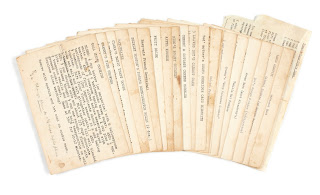In 2017, Eva gave me a tomato soup cake that she made (frosting on the side and as I have no pride left I can admit that I ate what did not make it onto the cake directly out of the jar with a spoon. It was that good).
Plath's tomato soup spice cake is fairly legendary. Plath herself mentions it just once in her letters (15 September 1961, from Court Green; Letters, Vol. II, p. 649, Amazon) and no times, that I could find, in her journals. Plath did make several references to it in her 1962 Letts tablet. On 22, 25, and 26 February and 10 May. The cake has a life of its own on the internet, frequently being written about, but always using someone else's recipe. Until now.
Lot 45 of Frieda Hughes' auction of Sylvia Plath and Ted Hughes items includes some recipe cards and a rolling pin. One of the recipes is "her" Tomato Soup Spice Cake. I say "her", in quotes, but really the recipe is not Sylvia Plath's at all. Sotheby's did not include the full recipe as a visible item in their photograph (above, left). However, I can report the following. (And, no, I did not buy the cards.)
Sylvia Plath's tomato soup spice cake recipe was sent to her by her mother, Aurelia Schober Plath, sometime after she visited England from June to August 1961. It is on page three of a four page letter (pages one and two seem not to be extant). Page three is on the recto of the leaf of tissue-thin paper; page four on the verso. ASP's signature is in pencil. There is a reference to Molly in ASP's letter, which was instrumental in dating it, as Molly was the "little Australian hairdressser" living in the Merwin's house, where Mrs. Plath primarily stayed during of her visit to England that summer (Letters, Vol II., p. 623). So, Mrs. Plath's letter likely dates from mid-to-late August or very early September 1961.
We can infer from Plath's letter of 15 September, cited above, that she had tried to make it. She writes: "I didn't think to question, but our cans seem to be bigger than yours, as my cake was a bit 'wet'." Aurelia Plath's clearly responded as Plath wrote in "10½ oz" on the retained page letter.
Last weekend my wife made the cake. I wanted to do it, but I am what is termed a "Kitchen Disaster." We made some executive decisions based on our own taste preferences. Such as we skipped the nutmeg and allspice. And no raisins. Raisins are, to quote my wife, "the devil's fruit." We topped it with a cream cheese frosting and walnuts. The instructions do not include the pan size, so we used a 9" x 13" pan. Mrs Plath cut hers into squares after placing a walnut on it, so that everyone got a walnut. So, so very nice and special and thoughtful.
Was the cake good? Oh yeah. And the walnuts are a really nice touch.
Here are some images.
 |
| Most of the ingredients |
 |
| Viciousness in the kitchen! |
 |
| Ready to bake |
 |
| Baked |
 |
| Getting there...the icing |
 |
| BAM!! |
 |
| This is the "good" side |
If you benefited from this post or any content on the Sylvia Plath Info Blog, my website for Sylvia Plath (A celebration, this is), and @sylviaplathinfo on Twitter, then please consider sending me a tip via PayPal. Thank you for at least considering! All funds will be put towards my Sylvia Plath research.
All links accessed 17 July 2021.



